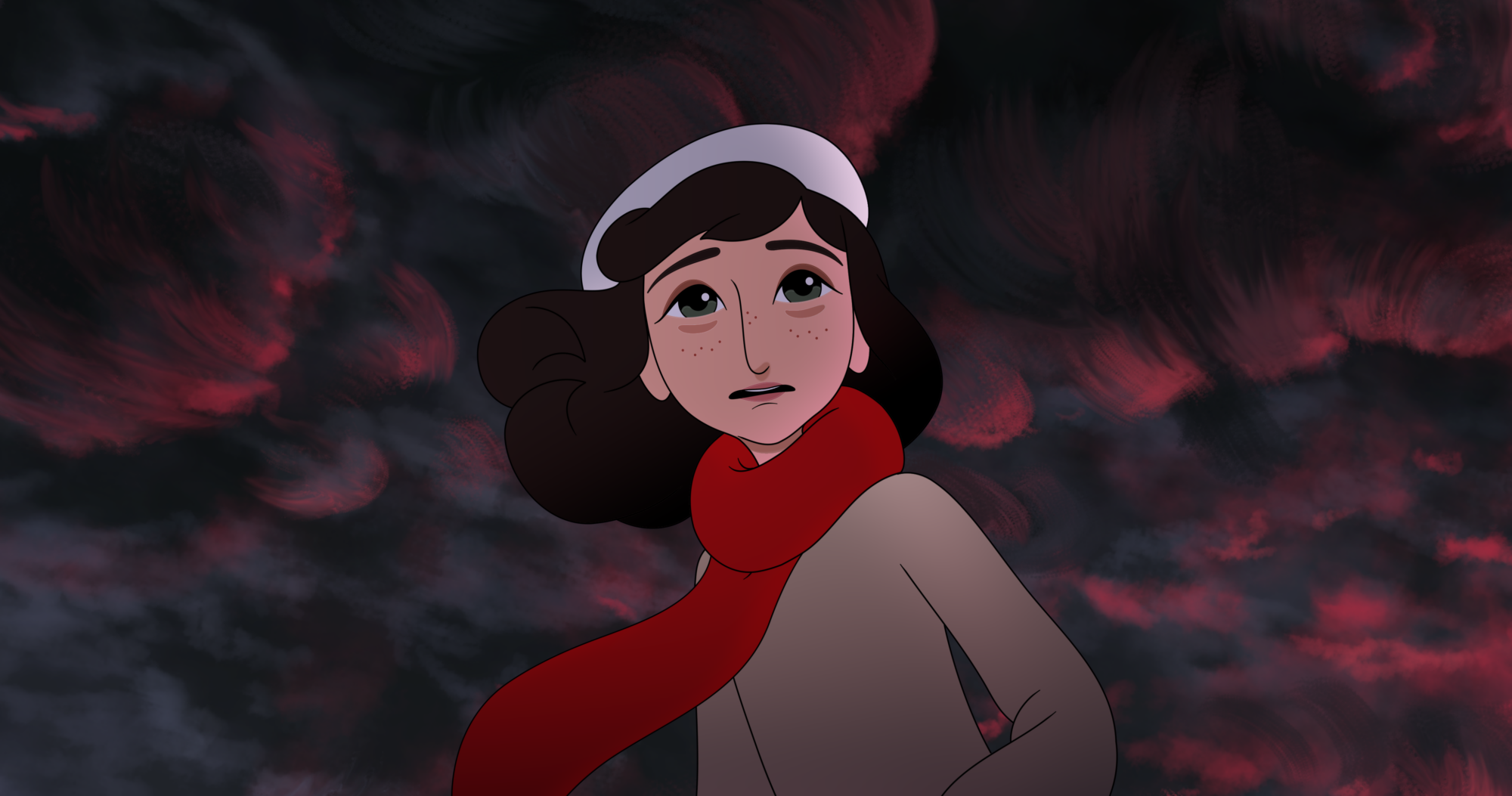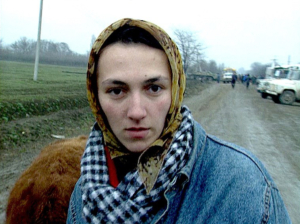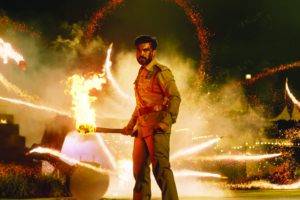In the aftermath of World War II, uncovering and attesting to the truth of the Holocaust was both a vital act of acknowledgement and an attempt to reclaim civil society. The immense scale of the Holocaust is an integral part of this history, but so too is the humanity of those who were persecuted. This is why Anne Frank’s diary – written from 1942 to 1944 while its author and her family hid from the Nazis in Amsterdam – has long had the capacity to connect readers with the experience of the Holocaust: by presenting those events from an ordinary Jewish teenager’s perspective, it has played a crucial role in fostering a broader cultural understanding of them. The diary – first published in English in 1952, under the title Anne Frank: The Diary of a Young Girl – is a significant testament to what researcher Zoë Waxman describes as ‘the intensely personal nature of Holocaust experiences’,[1]Zoë Waxman, ‘Why We Should Remember the English Translation of Anne Frank’s Diary’, History Extra, 28 April 2022, <https://www.historyextra.com/period/20th-century/why-remember-anne-frank-diary-translation>, accessed 6 October 2022. and it has inspired many film and TV versions of Frank’s story.
The animated feature Where Is Anne Frank (Ari Folman, 2021) seeks to tell this story in a new way, and to – in the words of the Anne Frank Fonds, the Swiss archival nonprofit that was the project’s key instigator – ‘find a new language to tell the story for a new generation’.[2]Quoted in ‘Q&A with the Anne Frank Fonds’, Where Is Anne Frank official website, <https://www.whereisannefrank.com/en/behind-the-scenes/q-and-a-with-the-anne-frank-fonds>, accessed 6 October 2022.
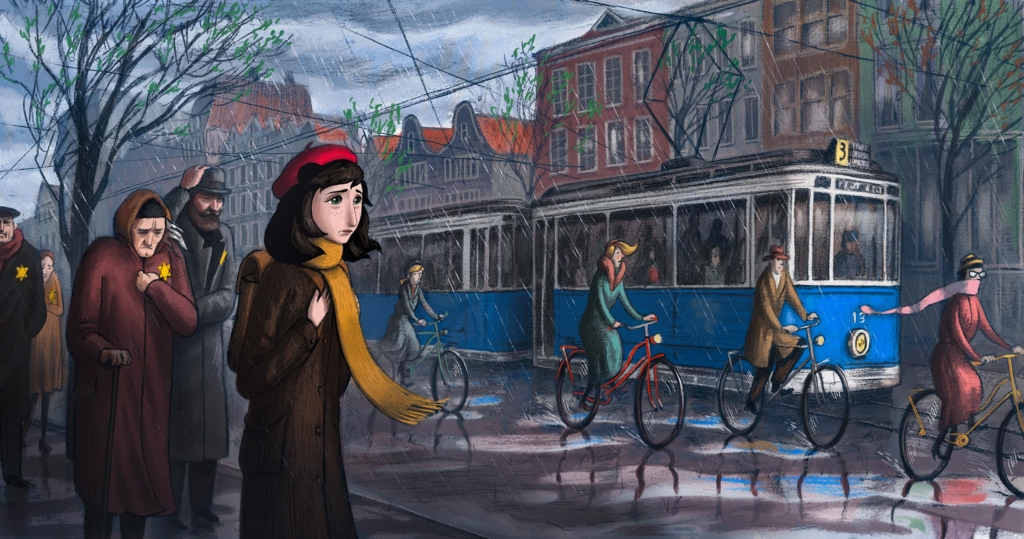
In the context of the digital age and the proliferation of conflicting public narratives, misinformation and ideologically driven disinformation,[3]See United Nations Educational, Scientific and Cultural Organization, History Under Attack: Holocaust Denial and Distortion on Social Media, 2022, available at <https://unesdoc.unesco.org/ark:/48223/pf0000382159>, accessed 30 November 2022. even the most significant and stable histories are vulnerable to being misremembered or forgotten. Where Is Anne Frank’s retelling of its eponymous subject’s story was motivated in particular by concerns that the humanity and truth of the experience recounted in her diary were being threatened by ‘increasing Holocaust denial, discrimination, anti-Semitism and a lack of knowledge’.[4]ibid. Yet the film looks not only to maintaining the integrity of history but also to its echoes in the present: in bearing witness to Frank’s experience, it seeks to apply the lessons the diary teaches about human rights and social justice to a portrayal of present-day victims of violence and persecution. This is in keeping with the ethos of the Anne Frank Fonds, which was founded by Frank’s father, Otto, to ensure the preservation and ongoing recognition of her diary and foster peace and fellowship between societies.[5]See ‘History of the Foundation’, Anne Frank Fonds website, <https://www.annefrank.ch/en/fonds/history>, accessed 6 October 2022. This commitment to ‘fight[ing] for reconciliation and for human rights across the world’[6]Otto Frank, quoted in ‘Otto Frank’, Anne Frank House website, <https://www.annefrank.org/en/anne-frank/main-characters/otto-frank/>, accessed 6 October 2022. is reflected in Where Is Anne Frank.
The Anne Frank Fonds’ motivation for the project, first developed in 2009, was to use animation to engage younger audiences in Frank’s story.[7]‘Q&A with the Anne Frank Fonds’, op. cit. The organisation approached Israeli director Folman – whose earlier animated feature Waltz with Bashir (2008) had previously served as a powerful example of how animation can be used to communicate past trauma[8]See Steven Aoun, ‘Waltz with Bashir’, Metro, no. 163, 2009, pp. 148–52; and Alice Burgin, ‘Guilt, History and Memory: Another Perspective on Waltz with Bashir’, Metro, no. 164, 2010, pp. 70–4. – to helm Where Is Anne Frank; engaging in extensive archival research on the events and people depicted in the film, Folman also drew on his own personal history as a child of Holocaust survivors. This perspective has fed into his approach to these stories, he says:
Our mind is incapable [of creating] a visual connection to these stories and cannot fully grasp what happened […] I therefore created an allegory to relate the story, using the tools animation and drawing provide us to create imaginary worlds.[9]Ari Folman, quoted in ‘Q&A with Director Ari Folman’, Where Is Anne Frank website, <https://www.whereisannefrank.com/en/behind-the-scenes/q-and-a-with-director-ari-folman>, accessed 7 November 2022.
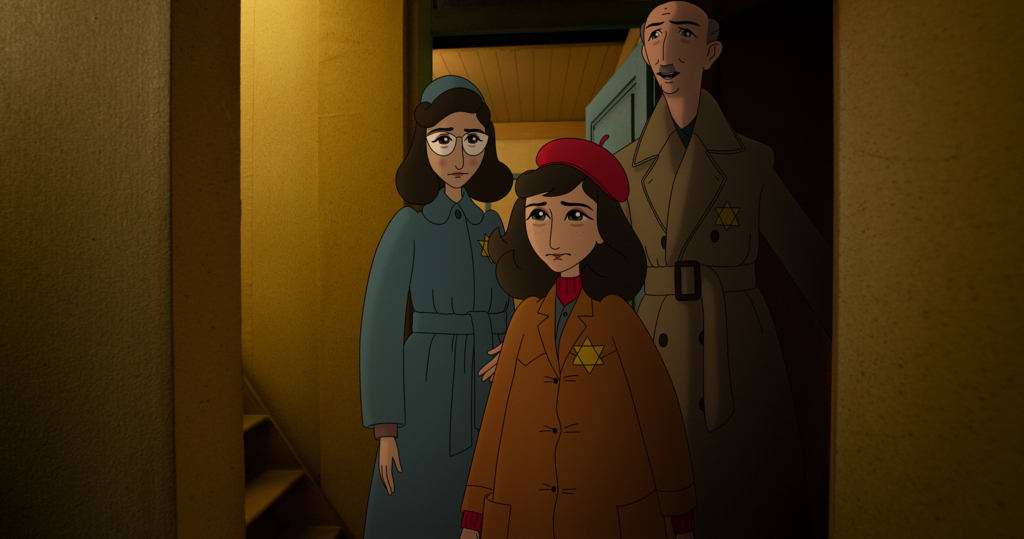
In Where Is Anne Frank, animation offers a means of paying homage to the imaginative energy of Frank’s writing by bringing the past to life in vibrant colours, while also metaphorically representing the horror of the Holocaust in a way that is appropriate for young audiences.
The film follows two timelines: one draws on the account provided by Frank in her diary; while the other is set in contemporary Amsterdam, ‘a year from now’. These two separate time periods are brought together through the character of Kitty (Ruby Stokes), inspired by the imaginary correspondent of the same name addressed by Frank in her diary entries.[10]‘I don’t want to jot down the facts in this diary the way most people would do, but I want the diary to be my friend, and I’m going to call this friend Kitty.’ Anne Frank, The Diary of a Young Girl: The Definitive Edition, trans. Susan Massotty, Viking, London & New York, 1995, p. 7. Emphasis in original. See more about Kitty and Anne’s other imagined correspondents here: ‘So, Who Is “Dear Kitty?”’, Anne Frank House website, <https://www.annefrank.org/en/anne-frank/diary/so-who-is-dear-kitty/>, accessed 15 November 2022. In Where Is Anne Frank, Kitty emerges from Anne’s diary into the present day and takes on the role of protagonist; her role is to act as a bridge between the events of the past and issues faced in contemporary Europe.
The film opens in the present day, in the street outside Amsterdam’s Anne Frank House museum during a storm. A small red tent is buffeted by the wind before being blown away, leaving the small refugee family inside unprotected from the driving rain. While this small drama is taking place, the museum visitors lining up to enter the Anne Frank House are oblivious to the family’s plight. This brief vignette sets the scene for the ensuing narrative, whose themes of empathy, compassion and activism are juxtaposed with a critique of ignorance and complacency.
In the following scene, the action moves inside the museum, where a lightning strike smashes the glass case containing Anne’s diary and Kitty emerges from the ink of the words written within. When, in an ant-like invasion, the museum visitors enter the house, Kitty moves among them like a ghost. As she drifts through the space, her memories of Anne (Emily Carey) bubble up, providing a vibrant counterpoint to the crowds of tourists tramping through the tiny rooms once occupied by the Franks (along with the van Pels family and Fritz Pfeffer[11]Respectively referred to pseudonymously as the van Daans and Albert Dussel in Frank’s diary. Folman’s film retains the latter alias, but its credits list the former family’s surname as ‘van Damm’.).

Kitty’s recollections orientate viewers, providing a background to the family’s plight and the strength of Anne’s perspective. As Kitty recalls the weeks before the family went into hiding, Anne’s fun-loving vitality and the warmth of her home life are represented through a rich and vibrant colour palette.[12]Folman and lead animator Lena Guberman chose to depict present-day Amsterdam in a grey monochrome. This is in direct contrast with scenes set in the past, which, the director explains, ‘is seen through the eyes of Anne’ and ‘is very lively, colourful and rich in tones […] We just went wild with colours, especially when her imaginations and dreams come up.’ Folman, quoted in ‘Q&A with Director Ari Folman’, op. cit. These memories begin with the celebration of Anne’s thirteenth birthday and the gift of the diary. But the family’s situation is shown to be fragile, and the celebration is interrupted by the chilling sound of an SS squad marching past the house. Their destructive power is communicated from a child’s-eye view, with the soldiers depicted as a phalanx of impossibly tall, white-masked demons (resembling a combination of Darth Vader, vampire, Dementor and killer robot). Yet, despite this looming threat, Anne remains full of fun and vitality, with her youthful capacity to live in the moment depicted in a pastel-hued, carnival-style sequence in which she boasts about all the boys in her class who are in love with her. This passage is contrasted in turn with subsequent dramatic scenes – presented as still images and expressionistic, silhouette-style animations – that portray the growing persecution of Jewish people in Amsterdam under Nazi occupation. Throughout Where Is Anne Frank’s narrative, stylistic shifts such as these highlight the myriad and highly individual ways in which people experience the world and remember that experience.
As a narrative device, Kitty’s character provides an effective means for educating viewers about the historical and current events that are so central to the film’s purpose. For nearly eighty years, she has been locked inside the diary that was left behind when the Frank family was rounded up; in a sense, she herself is a displaced person. Untethered from Anne’s voice and point of view, Kitty confronts the challenge of discovering and piecing together the events that followed the Frank family’s arrest and deportation while also learning about the twenty-first century world she finds herself in.
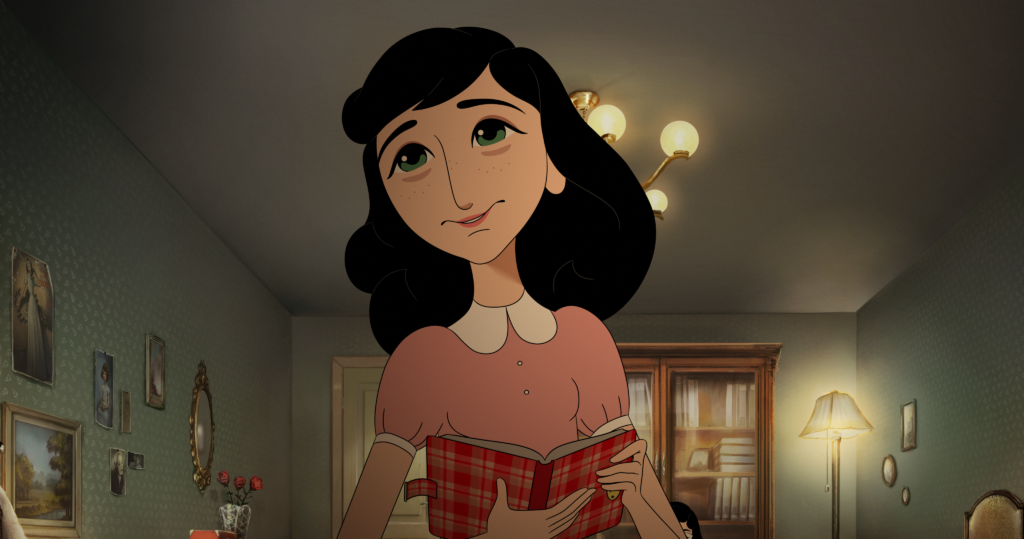
Kitty’s displacement is further emphasised by the fact that her existence relies on proximity to the diary, which she takes with her when she leaves the Anne Frank House – with the authorities, determined to retrieve it, in hot pursuit. However, like Anne and her family, Kitty also finds friends to support her, including a boy named Peter (Ralph Prosser),[13]A parallel figure to the Peter of Anne’s diary (Sebastian Croft), a fellow inhabitant of the secret annexe, for whom Anne experiences romantic stirrings. For more on the real-life Peter van Pels, see ‘Peter van Pels’, Anne Frank House website, <https://www.annefrank.org/en/anne-frank/main-characters/peter-van-pels/>, accessed 14 November 2022. who joins her when she retraces the journey that Anne took after being discovered. As Kitty speeds through the snow in a modern train, viewers are aware of the invisible layers of history and human suffering that are inextricably part of the deceptively pristine landscape outside. At this point in the story, Anne’s lively voice is silent, and Kitty reads Otto’s (Michael Maloney) memoir to fill in the gaps in her knowledge of Anne’s life.
Kitty’s escape from the Dutch authorities provides plenty of action-packed drama that keeps Where Is Anne Frank’s narrative moving along. Be that as it may, the heart of the film lies in the grim sequence that leads Kitty from Amsterdam to Anne’s grave in Germany. As the film recounts, the Frank family were first taken to the Westerbork transit camp before being transported to Auschwitz on the last train to ever leave the camp. Anne and her sister Margot were later separated from their parents and sent to the Bergen-Belsen concentration camp, where they both died of typhus.[14]See Howard Markel, ‘“One Day They Simply Weren’t There”: How Researchers Reconstructed Anne Frank’s Last Months’, PBS NewsHour, 12 June 2020, <https://www.pbs.org/newshour/health/one-day-they-simply-werent-there-how-researchers-reconstructed-anne-franks-last-months>, accessed 14 November 2022. The inclusion of these final seven months of Anne’s life was an integral part of the brief given to the filmmakers.
In representing the horror of the death camps and the unthinkable suffering that Anne and Margot faced, Folman has drawn on Frank’s passion for Greek mythology,[15]See ‘Q&A with Director Ari Folman’, op. cit. intermingling historical realities – such as the crowds of transportees, the dogs on the station platforms and the stripping of prisoners’ belongings – with imagery of a ferry taking people to an underworld ruled by Hades and guarded by the three-headed dog Cerberus. The power of this depiction relates to the ordinariness and vulnerability of the people Folman places within this mythological landscape. And similarly powerful is the scene in which Kitty and Peter pull out an iPad at Anne’s memorial to watch the first-person testimony of her schoolfriend Hanneli, who describes Anne’s loss of spirit in the camps and subsequent death.
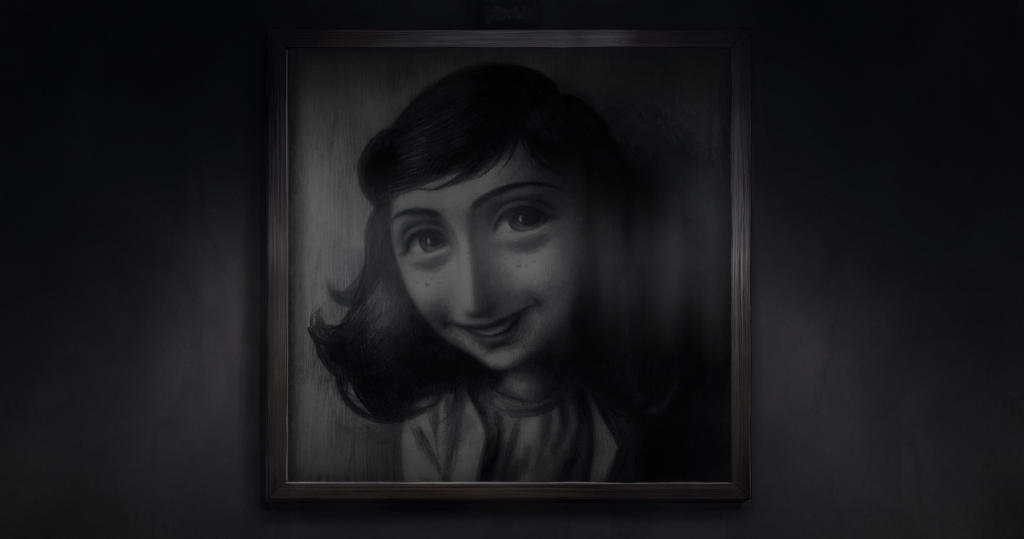
Along with educating young people about the events of the past, Where Is Anne Frank resists the commodification of Frank’s story and the fetishisation of her diary as an object of economic value (within, for instance, the Amsterdam tourism industry). Instead, the film draws on her legacy to connect viewers to the challenges faced by displaced people in present-day Europe: the refugee family introduced in the opening scene becomes the focus of a denouement based on values of empathy and social justice. Kitty learns from the family’s young daughter, Awa (Naomi Mourton), about how her family was forced to flee violence and war in Mali and has subsequently struggled to find a safe haven in Europe. Illustrated with still images that echo the graphic style and yellow-and-black colour palette used to depict Kristallnacht in the first act of Where Is Anne Frank, Awa’s account concludes with a list of the countries that have rejected her family: ‘Then we landed, seeking shelter: in Spain, no; Italy, no; Switzerland, no; France, no; Belgium, no. Then we came here; we were sure we would get shelter here …’ After hearing this story, Kitty is galvanised into action, using the diary as collateral to secure a safe and permanent place for the refugee families within Amsterdam, and thus restoring the purpose underpinning both the diary’s publication and the preservation of the secret annexe as a museum.
Where Is Anne Frank offers a vibrant and original approach to creating a historical narrative that will connect with and engage young audiences while also highlighting the relevance of the lessons of the past to present-day issues. As logically sketchy as the film’s magic-realist narrative may be, there is no doubting the energy of its storytelling and the power of its experimentation with multiple animation styles. The film’s rich visual language attests to the complexity of human experience, while also guiding viewers through the dark history of the Holocaust in a way that is both thought-provoking and meaningful.
Endnotes
| 1 | Zoë Waxman, ‘Why We Should Remember the English Translation of Anne Frank’s Diary’, History Extra, 28 April 2022, <https://www.historyextra.com/period/20th-century/why-remember-anne-frank-diary-translation>, accessed 6 October 2022. |
|---|---|
| 2 | Quoted in ‘Q&A with the Anne Frank Fonds’, Where Is Anne Frank official website, <https://www.whereisannefrank.com/en/behind-the-scenes/q-and-a-with-the-anne-frank-fonds>, accessed 6 October 2022. |
| 3 | See United Nations Educational, Scientific and Cultural Organization, History Under Attack: Holocaust Denial and Distortion on Social Media, 2022, available at <https://unesdoc.unesco.org/ark:/48223/pf0000382159>, accessed 30 November 2022. |
| 4 | ibid. |
| 5 | See ‘History of the Foundation’, Anne Frank Fonds website, <https://www.annefrank.ch/en/fonds/history>, accessed 6 October 2022. |
| 6 | Otto Frank, quoted in ‘Otto Frank’, Anne Frank House website, <https://www.annefrank.org/en/anne-frank/main-characters/otto-frank/>, accessed 6 October 2022. |
| 7 | ‘Q&A with the Anne Frank Fonds’, op. cit. |
| 8 | See Steven Aoun, ‘Waltz with Bashir’, Metro, no. 163, 2009, pp. 148–52; and Alice Burgin, ‘Guilt, History and Memory: Another Perspective on Waltz with Bashir’, Metro, no. 164, 2010, pp. 70–4. |
| 9 | Ari Folman, quoted in ‘Q&A with Director Ari Folman’, Where Is Anne Frank website, <https://www.whereisannefrank.com/en/behind-the-scenes/q-and-a-with-director-ari-folman>, accessed 7 November 2022. |
| 10 | ‘I don’t want to jot down the facts in this diary the way most people would do, but I want the diary to be my friend, and I’m going to call this friend Kitty.’ Anne Frank, The Diary of a Young Girl: The Definitive Edition, trans. Susan Massotty, Viking, London & New York, 1995, p. 7. Emphasis in original. See more about Kitty and Anne’s other imagined correspondents here: ‘So, Who Is “Dear Kitty?”’, Anne Frank House website, <https://www.annefrank.org/en/anne-frank/diary/so-who-is-dear-kitty/>, accessed 15 November 2022. |
| 11 | Respectively referred to pseudonymously as the van Daans and Albert Dussel in Frank’s diary. Folman’s film retains the latter alias, but its credits list the former family’s surname as ‘van Damm’. |
| 12 | Folman and lead animator Lena Guberman chose to depict present-day Amsterdam in a grey monochrome. This is in direct contrast with scenes set in the past, which, the director explains, ‘is seen through the eyes of Anne’ and ‘is very lively, colourful and rich in tones […] We just went wild with colours, especially when her imaginations and dreams come up.’ Folman, quoted in ‘Q&A with Director Ari Folman’, op. cit. |
| 13 | A parallel figure to the Peter of Anne’s diary (Sebastian Croft), a fellow inhabitant of the secret annexe, for whom Anne experiences romantic stirrings. For more on the real-life Peter van Pels, see ‘Peter van Pels’, Anne Frank House website, <https://www.annefrank.org/en/anne-frank/main-characters/peter-van-pels/>, accessed 14 November 2022. |
| 14 | See Howard Markel, ‘“One Day They Simply Weren’t There”: How Researchers Reconstructed Anne Frank’s Last Months’, PBS NewsHour, 12 June 2020, <https://www.pbs.org/newshour/health/one-day-they-simply-werent-there-how-researchers-reconstructed-anne-franks-last-months>, accessed 14 November 2022. |
| 15 | See ‘Q&A with Director Ari Folman’, op. cit. |
